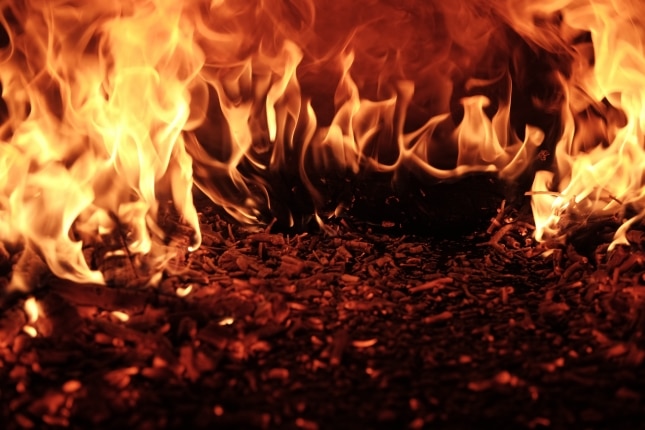It is common among evangelicals in general, and those of Charismatic or Pentecostal leanings in particular, to interpret the “baptism of fire” as another term for the “baptism of the Holy Spirit.” Thus, when John the Baptist says “I baptize you with water for repentance, but He who is coming after me…will baptize you with the Holy Spirit and fire,” (Matthew 3:11, Luke 3:16), they understand this to be one positive promise to believers that they will be baptized both “with the Holy Spirit” and “with fire.” In context, however, these are two separate things. The baptism of the Holy Spirit is a positive promise to believers who will be immersed in the Spirit and sealed by Him unto eternal life. The baptism of fire, however, is a negative promise of judgment to the unbeliever. Jesus will baptize everyone with one or the other. You either receive the Spirit from Christ or else He will cast you into the fire. This was John’s point.
The Immediate Context of baptism by fire
Looking at the surrounding context helps us to illuminate the point John was trying to make. Note all the imagery Matthew reports John using when he spoke these words:
“But when he saw many of the Pharisees and Sadducees coming for baptism, he said to them, ‘You brood of vipers, who warned you to flee from the wrath to come? Therefore bear fruit in keeping with repentance; and do not suppose that you can say to yourselves, “We have Abraham for our father”; for I say to you that from these stones God is able to raise up children to Abraham. The axe is already laid at the root of the trees; therefore every tree that does not bear good fruit is cut down and thrown into the fire. As for me, I baptize you with water for repentance, but He who is coming after me is mightier than I, and I am not fit to remove His sandals; He will baptize you with the Holy Spirit and fire. His winnowing fork is in His hand, and He will thoroughly clear His threshing floor; and He will gather His wheat into the barn, but He will burn up the chaff with unquenchable fire,'” (Matthew 3:7-12).
This passage is primarily a warning about coming judgment and the need to repent before it’s too late. In it, fire is mentioned three times in swift succession:
- The trees that do not bear fruit will be cut down and thrown into the fire.
- Jesus will come to baptize with the Holy Spirit and with fire.
- The wheat will be brought to the barn while the chaff is burned with fire.
What is the fire in these contexts? And what is Jesus coming to do? In the first instance, Jesus comes with an axe. The trees bearing fruit stand while those that do not are cut down and burned. Thus, Jesus comes to make a distinction between those who bear fruit (the “fruit in keeping with repentance” already mentioned in the passage) and those that do not. He preserves the one and destroys the other. That destruction is represented by fire. The third instance is quite similar to the first. In it, Jesus comes with a winnowing fork to separate the wheat from the chaff. The wheat is preserved and the chaff is, again, destroyed by fire. Fire here is clearly divine judgment.
Sandwiched in-between these two is the statement about Jesus coming to baptize them (i.e. the crowd that John is warning and calling to repentance) with “the Holy Spirit and with fire.” In context, this is saying the very same thing. Jesus is coming to separate the repentant faithful (who will be preserved) from the unrepentant wicked (who will be burned in the fire of His judgment.) The Gospel of Luke gives us a similar picture. After presenting the same image as Matthew about the axe and the casting of unfruitful trees into the fire, (Luke 13:7-9) Luke expands more fully on John’s call to repentance, (Luke 13:10-14). Luke then concludes:
“Now while the people were in a state of expectation and all were wondering in their hearts about John, as to whether he was the Christ, John answered and said to them all, ‘As for me, I baptize you with water; but One is coming who is mightier than I, and I am not fit to untie the thong of His sandals; He will baptize you with the Holy Spirit and fire. His winnowing fork is in His hand to thoroughly clear His threshing floor, and to gather the wheat into His barn; but He will burn up the chaff with unquenchable fire,” (Luke 3:15-17).
Once again, the context is a fearful call to repentance and a coming judgment of some and the preservation of others. Thus, the baptism of the Spirit is the promised hope of every believer and the baptism of fire is the dire fate of every unbeliever.
No Judgment, No Fire
It is also worth noting that the other two gospels present far less detail on the content of John’s preaching. Specifically, neither of them mentions John’s warnings of impending judgment or his vivid image of trees and chaff being cast into the fire. As such, when they present John’s words about Christ, they likewise leave out the reference to fire there too:
“And he was preaching, and saying, ‘After me One is coming who is mightier than I, and I am not fit to stoop down and untie the thong of His sandals. I baptized you with water; but He will baptize you with the Holy Spirit,'” (Mark 1:7-8).
“John testified saying, ‘I have seen the Spirit descending as a dove out of heaven, and He remained upon Him. I did not recognize Him, but He who sent me to baptize in water said to me, “He upon whom you see the Spirit descending and remaining upon Him, this is the One who baptizes in the Holy Spirit.” I myself have seen, and have testified that this is the Son of God,’” (John 1:32-34).
Thus, when judgment is not in view, we are not told about a “baptism of fire.” Similarly, Luke later reports the similar words of Jesus echoing John’s comments. The context of these quotes, however, is specifically directed to the disciples and the hopeful promise of the Holy Spirit. Thus, in those contexts, Luke says:
“Gathering them together, He commanded them not to leave Jerusalem, but to wait for what the Father had promised, ‘Which,’ He said, ‘you heard of from Me; for John baptized with water, but you will be baptized with the Holy Spirit not many days from now,'” (Acts 1:4-5).
“‘And as I began to speak, the Holy Spirit fell upon them just as He did upon us at the beginning. And I remembered the word of the Lord, how He used to say, ‘John baptized with water, but you will be baptized with the Holy Spirit.’ Therefore if God gave to them the same gift as He gave to us also after believing in the Lord Jesus Christ, who was I that I could stand in God’s way?’” (Acts 11:15-17).
In every one of these cases where the judgment of the wicked is not discussed and only the positive promise to believers is in view, the language about baptizing in fire is absent.
The Old Testament Background
While the exact language of being “baptized” (or “immersed”) in the Holy Spirit was coined by John the Baptist and Jesus, the image is drawn from Old Testament prophesy. Thus, the book of Acts opens with a reminder of the promise that Jesus would baptize His followers with the Holy Spirit (Acts 1:4-5) and then explains when this happens, that it was a fulfillment of the earlier promise recorded by the prophet Joel:
“but this is what was spoken of through the prophet Joel: ‘And it shall be in the last days,’ God says, ‘That I will pour forth of My Spirit on all mankind; And your sons and your daughters shall prophesy, And your young men shall see visions, And your old men shall dream dreams; Even on My bondslaves, both men and women, I will in those days pour forth of My Spirit And they shall prophesy,” (Acts 2:16-18, see Joel 2:28-29).
Thus, to be “baptized” in the Holy Spirit was, in Old Testament terms, to have the Spirit “poured out” on you. Both denoted covering as with water, thus making sense of John’s analogy to water baptism. In the same way, the Old Testament prophets likewise used a similar image related to the idea of a “fire baptism.” For example:
“‘Therefore wait for Me,’ declares the Lord, ‘For the day when I rise up as a witness. Indeed, My decision is to gather nations, To assemble kingdoms, To pour out on them My indignation, All My burning anger; For all the earth will be devoured By the fire of My zeal,'” (Zephaniah 3:8).
The burning fire of God’s indignation will be poured out on all the nations and peoples of the earth. This is the baptism of fire. Similar language is used for God’s judgment elsewhere, such as:
“He has bent His bow like an enemy; He has set His right hand like an adversary And slain all that were pleasant to the eye; In the tent of the daughter of Zion He has poured out His wrath like fire,” (Lamentations 2:4).
“The Lord has accomplished His wrath, He has poured out His fierce anger; And He has kindled a fire in Zion Which has consumed its foundations,” (Lamentations 4:11).
“Who can stand before His indignation? Who can endure the burning of His anger? His wrath is poured out like fire And the rocks are broken up by Him,” (Nahum 1:6).
“Thus I have poured out My indignation on them; I have consumed them with the fire of My wrath; their way I have brought upon their heads,” declares the Lord God,” (Ezekiel 22:31).
Thus, just as the “baptism of the Spirit” pointed back to promises of God “pouring out His Spirit, ” so too did the image of a “baptism of fire” point back to the imagery of God pouring out the fire of His wrath.
Other Examples
This idea of separating all humanity into two categories, one preserved to eternal life and the other plunged into the fire, is central to Jesus’ understanding of His own ultimate mission. Note, for example, the poignant kingdom parable of the wheat and the tares:
“Jesus presented another parable to them, saying, ‘The kingdom of heaven may be compared to a man who sowed good seed in his field. But while his men were sleeping, his enemy came and sowed tares among the wheat, and went away. But when the wheat sprouted and bore grain, then the tares became evident also. The slaves of the landowner came and said to him, “Sir, did you not sow good seed in your field? How then does it have tares?” And he said to them, “An enemy has done this!” The slaves said to him, “Do you want us, then, to go and gather them up?” But he said, “No; for while you are gathering up the tares, you may uproot the wheat with them. Allow both to grow together until the harvest; and in the time of the harvest I will say to the reapers, ‘First gather up the tares and bind them in bundles to burn them up; but gather the wheat into my barn,'”‘” (Matthew 13:24-30).
Jesus explained the parable’s meaning thus:
“And He said, ‘The one who sows the good seed is the Son of Man, and the field is the world; and as for the good seed, these are the sons of the kingdom; and the tares are the sons of the evil one; and the enemy who sowed them is the devil, and the harvest is the end of the age; and the reapers are angels. So just as the tares are gathered up and burned with fire, so shall it be at the end of the age. The Son of Man will send forth His angels, and they will gather out of His kingdom all stumbling blocks, and those who commit lawlessness, and will throw them into the furnace of fire; in that place there will be weeping and gnashing of teeth. Then the righteous will shine forth as the sun in the kingdom of their Father. He who has ears, let him hear,” (Matthew 13:37-43).
The whole point here is the same as the imagery used earlier by John the Baptist. Jesus has come to preserve believers unto eternal life and cast unbelievers into the fire of divine judgment. This is a central theme in Jesus’ teaching, especially in Matthew, and the two baptisms of Spirit and fire are just one of the many expressions of it. Note, again, the future judgment scene described in Matthew 25. We are told:
“But when the Son of Man comes in His glory, and all the angels with Him, then He will sit on His glorious throne. All the nations will be gathered before Him; and He will separate them from one another, as the shepherd separates the sheep from the goats; and He will put the sheep on His right, and the goats on the left,” (Matthew 25:31-33).
On the one hand, Jesus says to believers:
“Then the King will say to those on His right, ‘Come, you who are blessed of My Father, inherit the kingdom prepared for you from the foundation of the world,” (Matthew 25:34).
On the other hand, He says to the rest:
“Then He will also say to those on His left, ‘Depart from Me, accursed ones, into the eternal fire which has been prepared for the devil and his angels,” (Matthew 25:41).
He then concludes by reiterating:
“These will go away into eternal punishment, but the righteous into eternal life,” (Matthew 25:46).
Again, Jesus came to seal some for His eternal kingdom and will cast others to the fire. The Baptism of fire is God’s wrath on the unbeliever. It is not the blessing promised to the believer. We see this, perhaps most strikingly of all, when that baptism is described in Revelation:
“And if anyone’s name was not found written in the book of life, he was thrown into the lake of fire,” (Revelation 20:15).
Those who are plunged into the lake of fire are the unbelievers cast into eternal torment. This is the baptism of fire that Jesus will bring. The message is to repent! Believe in Christ and be delivered from the fire! Receive instead the Holy Spirit as a seal unto eternal life!






